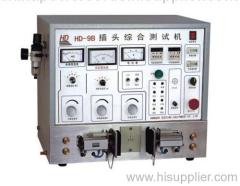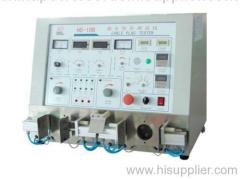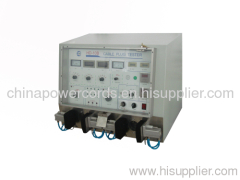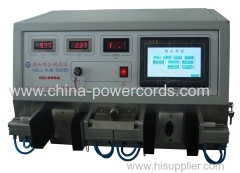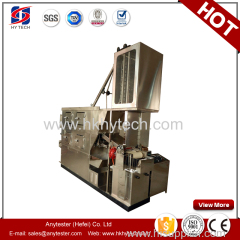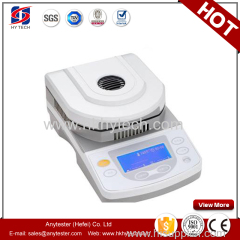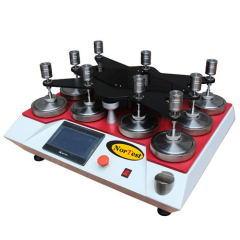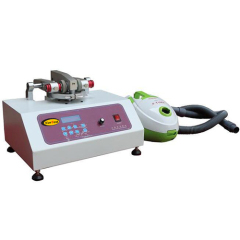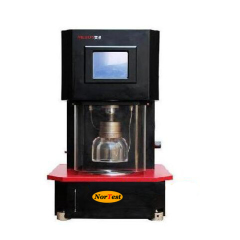
|
Nortest Instrument Co., Ltd
|
ASTM D4970 ISO12945-2 Martindale Abrasion And Pilling Tester
| Price: | 100.0 USD |
| Payment Terms: | T/T,L/C,WU,Paypal,Money Gram |
| Place of Origin: | Shanghai, China (Mainland) |
|
|
|
| Add to My Favorites | |
| HiSupplier Escrow |
Product Detail
YG(B)401E Nortest Brand Martindale abrasion tester is based on the Martindale method of standard system, to test the abrasion resistance of fabrics.
[Introduction]
YG(B)401E Series Nortest Brand Martindale abrasion tester is based on the Martindale method of standard system and the relationship between the textile products tested, and through this test to test the wear characteristics of the fabric, and wear resistance is an important indicator of textile product quality, it A direct impact on the durability and use of products, wear is between the fabric or with other substances in the process of repeated friction, resistance to wear characteristics. Wear-resistant fabric for testing the machine, that is, Martindale wear-resistant instrument.
[According standard]
DINENISO12947-7-2007 Martindale abrasion meter is made according to the standard, but because of the different national and regional standard series, we can divide them into international standards, the United States, European Union, Germany, Britain, China standards.
Details as follows:
International standards
ISO 12947.2-1998 "Textiles - Determination of the abrasion resistance of fabrics by the Martindale method - Part 2: Determination of specimen breakage";
ISO 12947.3-1998 "Textiles - Determination of abrasion resistance of fabrics by the Martindale method - Part 3: Determination of mass loss";
ISO 12947-4-1998 "Textiles - Determination of the abrasion resistance of fabrics by the Martindale method - Part 4: Assessment of changes in appearance".
American Society for Materials ASTM Standards
ASTMD4966-2010 "Abrasion resistance testing of fabrics Martindale Abrasion Tester".
EU standards
ENISO12947-2: 1998 "Textiles - Determination of abrasion resistance of fabrics by Martindale method - Part 2: Determination of specimen breakage";
ENISO 12947-3: 1998 "Textiles - Determination of abrasion resistance of fabrics by the Martindale method - Part 3: Determination of mass loss";
ENISO 12947-4: 1998 "Textiles - Determination of abrasion resistance of fabrics by the Martindale method - Part 4: Assessment of changes in appearance".
German Society for Standardization DIN standard
Textiles - Determination of abrasion resistance of fabrics by the Markov method - Part 2: Determination of destructive test properties; DINENISO 12947-2-2007.
DINENISO12947-3-2007 "Textiles - Determination of abrasion resistance by Markov method - Part 3: Determination of mass loss";
Textiles - Determination of the abrasion resistance of fabrics by the Martindale method - Part 4: Evaluation of changes in appearance (ISO 12947-7: 2007);
British Standards Institute BS standard
BSISO12947.2-1998 "Textiles - Determination of the abrasion resistance of fabrics by the Martindale method - Part 2: Determination of specimen breakage";
BSISO12947.3-1998 "Textiles - Determination of abrasion resistance of fabrics by the Martindale method - Part 3: Determination of mass loss";
BSENISO12947-4-1999 "Determination of abrasion resistance of textile fabrics by Martindale method - Part 4: Assessment of appearance changes".
Chinese National Standard
GB / T21196.2-2007 "Textiles - Determination of abrasion resistance of fabrics by Martindale method - Part 2: Determination of specimen breakage";
GB / T21196.3-2007 "Textiles - Determination of abrasion resistance of fabrics by the Martindale method - Part 3: Determination of mass loss";
GB / T21196.4-2007 "Textiles - Determination of abrasion resistance of fabrics by the Martindale method - Part 4: Assessment of changes in appearance".
[Instrument parameters]
1, the number of stations: 4, 6, 9
2, the counting range: 0 ~ 999999 times
3, the maximum movement: horizontal: 60 ± 0.5mm longitudinal: 24 ± 0.5mm
4, the pressurized material quality:
A, holder: 198 ± 2g
B. Weight of cloth sample weight: 395 ± 2g
C. Furniture accessories sample weight hammer: 595 ± 2g
5, the effective friction block diameter:
A type 200g (1.96N) friction head (9KPa) ¢ 28.8-0.084mm
6, the relative motion of the holder and the grinding table speed: 50 ± 2r / min, 47 ± 2r / min
7, loading the quality of pressure hammer: 2500g ± 25
8, Dimensions: 885 × 600 × 410mm
9, power supply: Ac220V 50Hz 500W
10, Weight: 150kg
[Features]
★ Scientific structural design, without moving the lid can easily load and unload the sample;
★ Kinds of test mode to choose from, and start ball and wear-resistant function, and the implementation of national standard and American Standard;
★ Chinese and English with optional menu interface, to adapt to different user needs;
★ imported 5.7-inch color touch screen control, the interface clear and easy to operate intuitive and convenient;
★ Using eight-station design, the test efficiency is greatly improved;
★ French original import (Shi Naide) programmable logic controller (PLC) modular control, reliable, stronger anti-interference, not easy to crash, suitable for long-running;
★ Adopt count down and count up two ways, and with a mid-way plus and cumulative count, user-friendly test.
[principle]
According to J.G.Martindale design principles, and in line with the wool Industry Research Association specifications produced by a testing equipment. It uses the standard wool felt as a friction material, to rub the test items such as cloth, etc., of course, can be based on different test methods, different requirements, to change the friction material standard wool felt for other materials such as sandpaper to test leather wear Sexual or decolorization degree. The measured object is clamped on a cylinder and weighted by a standard weight (depending on the test method, pressing on the abrasive object, driven by vertical and horizontal eccentric wheels, to produce a Li Sha-Ru curve for the purpose of completing a multi- Friction test.For the general footwear material, when wearing friction effect test, mostly at the same time to dry, wet two methods to detect, to simulate the rain on the upper material, or sweat on the extent of the impact inside the shoe.
[Test procedure]
1. The sample is parked in a laboratory environment for more than 8 hours.
2. Cut a sample in the flat part of the specimen. In case of insoles, should be cut to the transfer site.
3. Remove the load and load shaft from the testing machine.
4. Remove the top plate and the test fixture.
5. Test device: loosen the test fixture on the fixed ring, out of the sample pressure, the sample into the test fixture base, in the sample and the test fixture between the base pad of a sample gasket, and then Place the test piece on the specimen pad and secure it with the retaining ring.
6. Felt and friction cloth of the device: Loosen the set screws and fixed ring, the sheep felt on the base and then covered with friction cloth, friction cloth on the pressure on the 2.5kg pressure plate, replace the fixed ring and Lock the fixing screw.
7. Replace the top plate and pass the load shaft (12KPa) through the round hole in the top plate.
8. Place the test fixture with the test specimen facing down on the base fixture, and align the test fixture circular groove with the load shaft so that the load shaft is inserted into the circular groove of the test fixture.
9. Press the standard set number of times to start the switch and start the test.
10. When the set number of times has been reached, the machine will stop automatically, and the sample judgment result will be removed.
[Characterization]
Martindale fabric abrasion resistance of the determination of the method of determination of sample damage, the determination of the quality of the loss of quality and appearance of three changes. Three methods are commonly used in the determination of specimen damage, the method error is small, clear and intuitive test results, the wear resistance of different fabrics easy to compare, in the clothing products, decorative fabrics commonly used. The quality loss measurement method and the appearance quality change method are more complex, but can reflect the abrasion state of the different friction stage samples. It has strong practicality in the production enterprises or scientific research institutions to analyze the use of the fabric. Wear resistance is an important indicator of the quality of textile products, a direct impact on product durability and use of results. Specifically refers to the fabric or with other substances in the process of repeated friction, resistance to wear characteristics.
Textile products wear mainly in the following aspects: First, the process of friction between the fibers continue to collision, the yarn fiber fragments due to fatigue damage fracture, leading to yarn breakage. Second, the fiber from the fabric out, resulting in loose yarn and fabric structure, repeated under the action of the fiber may be completely pulled out, resulting in thinning of the yarn, fabric thinning, or even disintegration. Third, the fiber is cut and broken, resulting in yarn breakage. Fourth, the fiber surface wear, fiber surface debris loss. Fifth, the friction produces high temperature, so that the fiber melt or plastic deformation, affecting the structure and mechanical properties of fiber. Wear performance in the fabric of the morphological changes are mainly damaged, the quality of the loss, the appearance of color, pilling and other changes.
Textile products, wear resistance testing a variety of methods, such as flat grinding method, song grinding method, hemming method and complex grinding method. Martindale method is a flat grinding method, is widely used in clothing, home textiles, decorative fabrics, furniture, fabric abrasion resistance testing.





